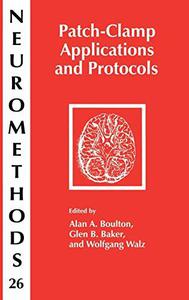 Patch-Clamp Applications and Protocols By Richard A. Levis, James L. Rae (auth.), Alan A. Boulton, Glen B. Baker, Wolfgang Walz (eds.)
Patch-Clamp Applications and Protocols By Richard A. Levis, James L. Rae (auth.), Alan A. Boulton, Glen B. Baker, Wolfgang Walz (eds.)1995 | 316 Pages | ISBN: 0896033112 | PDF | 24 MB
E. Neher and B. Sakman were the first to monitor the opening and closing of single ion channels and membranes by conductance measurements. In 1976, they used firepolished micropipets with a tip diameter of 3-5 pm to record currents from a small patch of the membranbe of sk- etal muscles, thereby decreasing background membrane noise. In order to reduce the dominant source of background noise-the leakage shunt under the pipet rim between m- the muscle membrane had to be treated brane and gla- enzymatically. Despite these early limitations, a new te- nique was born -the patch-clamp technique. The final bre- through came in 1981 when the same authors, in collaboration with 0. P. Hamill, A. Marty, and F. J. Sigworth, developed the gigaohm seal. Not only did this improve the quality of recordings, it was now possible to gently pull the membrane patch with the attached pipet off the cell and study its trapped ion channels in isolation. Another offshoot of the gigaohm seal technique was the whole-cell patch-clamp technique, in which the patch is ruptured without breaking the seal. This technique is really a sophisticated voltage-clamp technique and also allows for the altering of cytoplasmic constituents if the experimenter so wishes. The first part of Patch-Clamp Applications and Protocols presents modern developments associated with the techn- ogy of patch-clamp electrodes, of cell-free ion channel reco- ing, and of the whole-cell patch-clamp technique.



![S.T.A.L.K.E.R. 2 / STALKER 2: Heart of Chornobyl - Ultimate Edition (2024) [+UPDATE 23.12.2024 - v1.1.3] ElAmigos / Polska wersja językowa](https://i.postimg.cc/Zqd8RWGY/UZG8PBE.jpg)



















































![David Gilmour - Luck and Strange (2024) [FLAC]](https://i.imgur.com/everaBc.jpeg)
![Męskie Granie Orkiestra - Męskie Granie 2024 (2024) [FLAC]](https://i.imgur.com/FAyOxrM.jpeg)
![The Rolling Stones - Hackney Diamonds (2023) [FLAC]](https://i.imgur.com/wCkyyUN.jpg)
![Lady Gaga - Harlequin (2024) [FLAC]](https://i.imgur.com/dcgIA8D.jpeg)
![Natalia Kukulska - Dobrostan (2024) [FLAC]](https://i.imgur.com/bdljG3O.jpeg)
![Kaśka Sochacka - Ta druga (2024) [FLAC]](https://i.imgur.com/hORQKvn.jpeg)
![Kuba Sienkiewicz - Pani Bóg (2024) [FLAC]](https://i.imgur.com/qijCx8Z.jpeg)
![Lanberry - Heca (2024) [FLAC]](https://i.imgur.com/8P7QfeR.jpeg)
![Sara James - PLAYHOUSE (2024) [FLAC]](https://i.imgur.com/m4f8OKg.jpeg)
![Grzegorz Hyży - EPILOG (2024) [FLAC]](https://i.imgur.com/8DA2sBr.jpeg)
![Myslovitz - WIECZORAMI CHŁOPCY WYCHODZĄ NA ULICE (2024) [FLAC]](https://i.imgur.com/l9mMtIG.jpeg)
![Krzysztof Zalewski - ZGŁOWY (2024) [FLAC]](https://i.imgur.com/vh48RAc.jpeg)
![Krzysztof Cugowski - Wiek to tylko liczba (2024) [FLAC]](https://i.imgur.com/SBzgqe2.jpeg)
![Nosowska - Kasia i Błażej (2024) [FLAC]](https://i.imgur.com/mObvVXQ.jpeg)
![sanah - Pianinkowe Kaprysy (2024) [FLAC]](https://i.imgur.com/pVjjPAa.jpeg)
![Kwiat Jabłoni - Pokaz slajdów (2023) [FLAC]](https://i.imgur.com/diERHfZ.jpg)
![Robert Cichy - Spacer po Warszawie (2024) [FLAC]](https://i.imgur.com/ixleU9o.jpeg)
![Viki Gabor - Terminal 3 (2024) [FLAC]](https://i.imgur.com/Q1KCnDs.jpeg)
![Sanah - Kaprysy (2024) [FLAC]](https://i.imgur.com/71OZm4h.jpeg)
![Męskie Granie Orkiestra - Męskie Granie 2023 (2023) [FLAC]](https://i.imgur.com/U4YHo8d.jpg)




